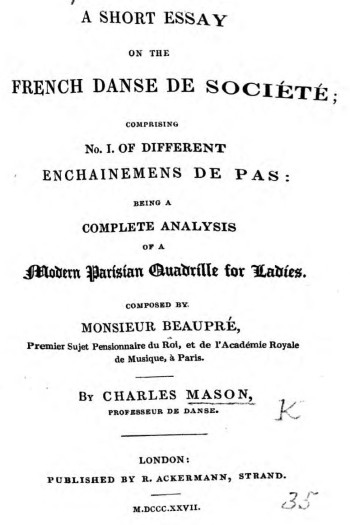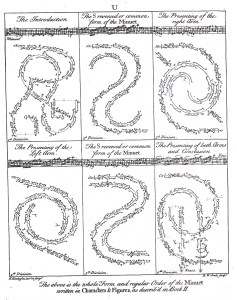Last weekend I attended (if that is the right word) a virtual festival of historical dance. One of the sessions was given by a young dancing master I have worked with over several years. He was looking at steps for the early 19th-century quadrille. I have written elsewhere about my difficulties with these – they are very similar to modern ballet vocabulary, except that they aren’t quite the same. He finished with the pas de Zephyr, a step I have also written about, which shows a clear link between the stage and the ballroom. There is currently ongoing discussion about the relationship between dancing on stage and in the ballroom, with some arguing for a clear division between the two while others consider that there was often little difference between them. For what it is worth, I think that the truth is rather more complicated. Much more research is needed before we can understand the various, and varying, relationships between stage dancing and ballroom dancing.
For the pas de Zephyr, the dancing master drew on a treatise by Charles Mason who described himself as ‘Professeur de Danse’ on the title page of his A Short Essay on the French Danse de Société published in 1827. The title page goes on to tell us that the treatise offers ‘No. I. of Different Enchainemens de Pas: being a Complete Analysis of a Modern Parisian Quadrille for Ladies’ and that this was composed by Monsieur Beaupré ‘Premier Sujet Pensionnaire du Roi, et de l’Académie Royale de Musique, à Paris’. Charles Mason may have been English, but for the purposes of his dance treatise he looked to the French. Here is the title page of Mason’s treatise.

Who was Monsieur Beaupré? At the end of his treatise Mason tells us that Beaupré taught ‘many of the French as well as the English nobility who visit Paris’. The title page tells us that he had enjoyed a dance career at the Paris Opéra, where he had attained the rank of ‘Premier Sujet’ and had earned a pension on his retirement. So, when was he dancing at the Opéra and what did he dance? As luck would have it, the answers to these questions can be found in two recent works of dance history – Ivor Guest’s The Ballet of the Enlightenment (London, 1996) and Ballet under Napoleon (Alton, 2001). Both are invaluable for exploring ballet at the Paris Opéra between 1770 and 1820.
According to Guest, Beaupré’s real name was Charles-Florentin Richer de la Rigaudière and he lived from 1764 to 1842. He made his debut at the Opéra in 1789 and finally retired (Guest uses the term ‘pensioned off’) in 1818. Beaupré was short in stature and evidently had a powerful virtuoso technique, which he put to good use in comic dancing. By 1793 he was a ‘senior comic dancer’ and by 1808 he had become the leading dancer in the genre comique. Guest also describes Beaupré as one of several ‘exceptionally gifted silent actors’ at the Opéra (Ballet under Napoleon, p. 482).
Beaupré’s development from virtuosic comic dancing to teaching the refinements of social dancing to the nobility calls to mind the similar trajectory of Francis Nivelon. The latter was a leading comic dancer in London during the 1720s and 1730s and, after he retired from the stage, became a teacher of social dancing. Nivelon wrote The Rudiments of Genteel Behaviour (1737) for aspiring members of the English gentry. Such careers raise many questions about the relationship between dancing on the stage and in the ballroom.
When Beaupré made his debut in 1789, a reviewer wrote of his ‘brilliant execution, great lightness and precision’ (Ballet of the Enlightenment, p. 298, citing Affices, annonces et avis divers, 15 October 1789). Beaupré may have made his career in the genre comique but he had a refined and sophisticated dance technique. Ivor Guest mentions several of Beaupré’s roles, but here I will focus on only one of the ballets in which he appeared, La Dansomanie, first performed at the Paris Opéra on 14 June 1800. Gardel’s ballet recounts the story of M. Duléger, who is obsessed with dancing, and the effects of his dansomanie on his daughter Phrosine and her suitor Colonel Demarsept. Duléger gets carried away as he watches the Gavotte de Vestris and decrees that Phrosine may only marry a man who can dance. Colonel Demarsept admits that he cannot dance and so an elaborate ruse is required to ensure his marriage to Phrosine. The joke behind this folie-pantomime was that Colonel Demarsept was performed by Auguste Vestris, the foremost danseur noble of the day.
La Dansomanie includes a dancing lesson for M. Duléger, with Louis-Jacques Milon as Flicflac the dancing master and Beaupré as his assistant Brisotin. The latter was depicted in his costume for the role a few years later.

Flicflac tries to teach M. Duléger not only the jeté battu, but also tems de cuisse ‘doublés’, ‘triplés’ and even ‘quadruplés’, as well as pirouettes sur le cou-de-pied. The lesson includes several jokes about the differences between social and stage dancing. As Brisotin, Beaupré presumably assisted Milon in demonstrating the latest, and most difficult steps to be seen on the stage of the Paris Opéra for Duléger to copy! La Dansomanie was first performed in London at the King’s Theatre on 15 May 1806 and was revived several times over the next few years. Mason may well have seen it both in Paris and in London, and probably taught pupils who had seen it too.









